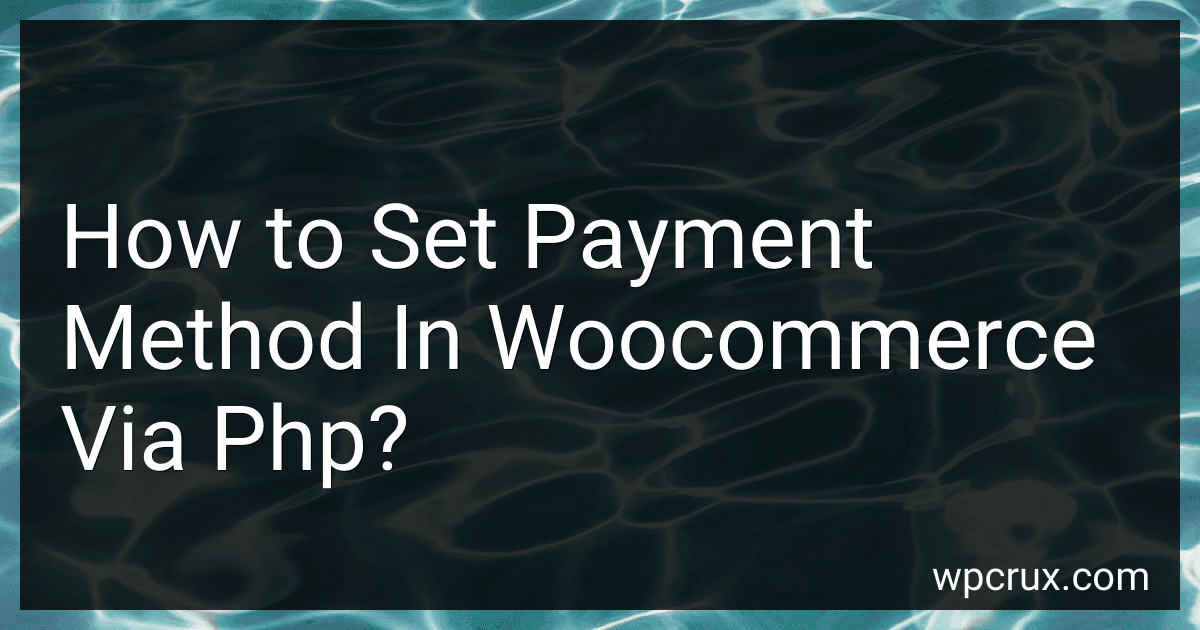Best WooCommerce Payment Plugins to Buy in October 2025
To set a payment method in WooCommerce via PHP, you can use the following code snippet:
First, you need to get the list of available payment gateways using the following code:
$payment_gateways = WC()->payment_gateways->get_available_payment_gateways();
Then, you can select the payment gateway you want to set as the default one. For example, if you want to set PayPal as the default payment gateway, you can use the following code:
WC()->session->set('chosen_payment_method', 'paypal');
Finally, you can save the chosen payment method using the following code:
WC()->cart->calculate_totals(); WC()->session->save_data();
This will set the payment method to PayPal for the current session in WooCommerce.
What is the proper way to handle errors when setting up a payment method in WooCommerce via PHP?
When setting up a payment method in WooCommerce via PHP, it is important to properly handle errors to provide a smooth user experience. Here are some best practices for handling errors when setting up a payment method in WooCommerce via PHP:
- Use try-catch blocks: Wrap the code that sets up the payment method in a try-catch block to catch any exceptions that may occur during the process.
- Log errors: Use logging functions such as error_log() or WooCommerce logging system to log any errors that occur during the setup process. This will help you troubleshoot and debug issues more easily.
- Display error messages: If an error occurs during the setup process, display a friendly error message to the user to inform them of the issue. This can help prevent confusion and frustration.
- Validate input data: Make sure to validate any input data before using it in your code to prevent unexpected errors. For example, check if all required fields are filled out and if the data is in the correct format.
- Handle specific error cases: Depending on the type of error that occurs, handle it appropriately. For example, if the payment provider API returns an error code, you can display a specific error message to the user or take specific actions to resolve the issue.
By following these best practices, you can ensure a more robust and reliable payment method setup process in WooCommerce via PHP.
How to set up a cash on delivery payment method in WooCommerce through PHP code?
To set up a cash on delivery payment method in WooCommerce through PHP code, you can use the following code snippet:
First, add the following code to your theme's functions.php file to register a new payment method:
add_filter( 'woocommerce_payment_gateways', 'add_cash_on_delivery_gateway' ); function add_cash_on_delivery_gateway( $gateways ) { $gateways[] = new WC_Cash_On_Delivery_Gateway(); return $gateways; }
Next, create a new class for the cash on delivery payment gateway:
class WC_Cash_On_Delivery_Gateway extends WC_Payment_Gateway { public function __construct() { $this->id = 'cash_on_delivery'; $this->method_title = 'Cash on Delivery'; $this->title = 'Cash on Delivery'; $this->has_fields = false; $this->init_form_fields(); $this->init_settings(); add_action( 'woocommerce_update_options_payment_gateways_' . $this->id, array( $this, 'process_admin_options' ) ); }
public function init\_form\_fields() {
$this->form\_fields = array(
'enabled' => array(
'title' => 'Enable/Disable',
'type' => 'checkbox',
'label' => 'Enable Cash on Delivery',
'default' => 'yes'
)
);
}
public function process\_payment( $order\_id ) {
$order = wc\_get\_order( $order\_id );
$order->update\_status( 'on-hold', \_\_( 'Awaiting cash on delivery payment', 'woocommerce' ) );
$order->reduce\_order\_stock();
WC()->cart->empty\_cart();
return array(
'result' => 'success',
'redirect' => $this->get\_return\_url( $order )
);
}
}
This code will create a new payment gateway called "Cash on Delivery" in your WooCommerce settings. Customers will be able to select this payment method during checkout and pay for their order when it is delivered.
Remember to test this code thoroughly on a staging site before implementing it on a live site.
What is the process for displaying a custom logo for a payment method in WooCommerce?
To display a custom logo for a payment method in WooCommerce, you will need to follow these steps:
- Upload your custom logo: First, upload your custom logo image to your website. You can do this by going to Media > Add New in your WordPress admin area and uploading your custom logo image file.
- Get the custom logo image URL: After uploading the logo image, copy the URL of the uploaded image. You will need this URL to display the logo in WooCommerce.
- Add code to functions.php: Open your theme's functions.php file and add the following code snippet to define a custom logo for the payment method:
add_filter( 'woocommerce_gateway_icon', 'custom_payment_method_logo', 10, 2 ); function custom_payment_method_logo( $icon, $id ) { if ( $id == 'payment_method_id' ) { // Replace 'payment_method_id' with the ID of the payment method you want to add the logo to $icon = ''; } return $icon; }
Replace 'payment_method_id' with the ID of the payment method you want to add the custom logo to and 'URL_OF_CUSTOM_LOGO' with the URL of the custom logo image you uploaded earlier.
- Save the changes: Save the changes to your functions.php file and refresh your website to see the custom logo displayed for the payment method.
By following these steps, you can easily display a custom logo for a payment method in WooCommerce.
How to set up a subscription payment method in WooCommerce programmatically?
To set up a subscription payment method in WooCommerce programmatically, you can use the following steps:
- Create a new WooCommerce payment gateway class that extends the WC_Payment_Gateway class. You can do this by creating a new PHP file in your theme or plugin directory.
- In the new payment gateway class, set the necessary properties and methods for the subscription payment method. This may include defining the payment gateway ID, title, description, supported features, and payment settings.
- Implement the process_payment method to handle the payment processing logic for the subscription payments. This method should create a new subscription order and process the payment using the payment gateway's API.
- Implement the process_refund method to handle refund requests for subscription payments.
- Register the new payment gateway class with WooCommerce using the woocommerce_payment_gateways filter hook. You can do this by calling the add_filter function in your theme or plugin's initialization code.
- Once the payment gateway is registered, it should appear in the WooCommerce settings under the Payment Gateways tab. You can then configure the payment settings for the subscription payment method.
By following these steps, you can set up a subscription payment method in WooCommerce programmatically. This allows you to customize and control the payment processing logic for subscription payments according to your specific requirements.
How can I add a new payment method to the WooCommerce checkout page using PHP?
To add a new payment method to the WooCommerce checkout page using PHP, you can follow these steps:
- Create a new payment gateway class by extending the WC_Payment_Gateway class. This class should include methods for initializing the payment gateway, setting up the payment form fields, and processing the payment request.
class Custom_Payment_Gateway extends WC_Payment_Gateway {
public function \_\_construct() {
// Initialize the payment gateway settings
}
public function init\_form\_fields() {
// Setup the payment form fields
}
public function process\_payment( $order\_id ) {
// Process the payment request
}
}
- Register your new payment gateway class with WooCommerce by hooking into the woocommerce_payment_gateways filter. This will make your custom payment gateway available for selection in the WooCommerce settings.
function add_custom_payment_gateway( $gateways ) { $gateways[] = 'Custom_Payment_Gateway'; return $gateways; } add_filter( 'woocommerce_payment_gateways', 'add_custom_payment_gateway' );
- Optionally, you can customize the display of the payment method on the checkout page by modifying the payment method title and description.
function customize_payment_method_display( $title, $payment_id ) { if ( $payment_id === 'custom_payment_gateway' ) { $title = 'Custom Payment Method'; } return $title; } add_filter( 'woocommerce_gateway_title', 'customize_payment_method_display', 10, 2 );
- Finally, you can add any necessary JavaScript or CSS to enhance the user experience of your custom payment method on the checkout page.
By following these steps, you can add a new payment method to the WooCommerce checkout page using PHP.
How to enable a payment method based on a specific user role in WooCommerce using PHP?
To enable a payment method based on a specific user role in WooCommerce using PHP, you can add a filter to check the user's role and conditionally enable or disable the payment method. Here's an example code snippet that you can use:
function custom_payment_gateway_available( $available_gateways ) { // Get current user $current_user = wp_get_current_user();
// Check if user is logged in and has a specific role
if ( is\_user\_logged\_in() && in\_array( 'customer\_role', $current\_user->roles ) ) {
// Add your payment method id here
$payment\_gateway\_id = 'your\_custom\_payment\_gateway\_id';
// Enable the payment gateway for the specific user role
$available\_gateways\[ $payment\_gateway\_id \] = WC()->payment\_gateways->payment\_gateways\[ $payment\_gateway\_id \];
}
return $available\_gateways;
} add_filter( 'woocommerce_available_payment_gateways', 'custom_payment_gateway_available' );
Make sure to replace 'customer_role' and 'your_custom_payment_gateway_id' with the actual user role and payment method id. You can find the payment method id by inspecting the HTML of the checkout page and locating the ID attribute of the payment method's radio button.
Add this code to your theme's functions.php file or a custom plugin. This code will enable the payment method only for users with the specified role when they are logged in.



